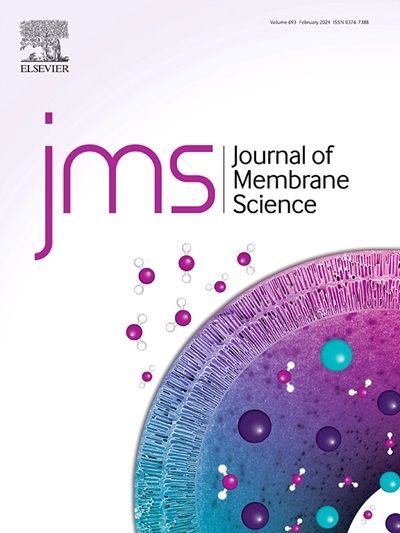Electrostatically enhanced surface segregation boosts anti-fouling performance of mixed matrix membranes
IF 8.4
1区 工程技术
Q1 ENGINEERING, CHEMICAL
引用次数: 0
Abstract
Introducing nanomaterials into polymeric membranes can significantly improve their separation performances, and surface enrichment of hydrophilic nanomaterials is beneficial for enhanced anti-fouling ability of membranes. However, existing strategies are difficult to achieve directional movement of nanomaterials in membrane matrix. Herein, for the first time, we report the directional migration of nanomaterials to membrane surface by electrostatically enhanced surface segregation, thus realizing a single-step formation of superior anti-fouling membrane. Two-dimensional MXene (Ti3C2Tx) nanosheets modified by cationic polyethyleneimine are added into the casting solution, while anionic polyacrylic acid is dissolved in the coagulation bath. During phase inversion, the synergistic interplay of electrostatic forces and hydrophilic interactions drove the directional migration of MXene, thereby constructing an anti-fouling layer on the membrane surface. The rationally designed MP-P membrane yields incredibly high anti-fouling performance against different pollutants with a flux recovery rate of more than 96 % after four cyclic experiments, which is about 68 % higher than the original membrane. Molecular dynamics simulations further revealed the driving forces behind the surface segregation behavior, the interactions among the components in anti-fouling layer and its anti-fouling mechanism. This method is widely applicable for directional migration of nanomaterials and provides a new pathway for the synthesis of next generation anti-fouling mixed matrix membranes for energy efficient molecular separation.

求助全文
约1分钟内获得全文
求助全文
来源期刊

Journal of Membrane Science
工程技术-高分子科学
CiteScore
17.10
自引率
17.90%
发文量
1031
审稿时长
2.5 months
期刊介绍:
The Journal of Membrane Science is a publication that focuses on membrane systems and is aimed at academic and industrial chemists, chemical engineers, materials scientists, and membranologists. It publishes original research and reviews on various aspects of membrane transport, membrane formation/structure, fouling, module/process design, and processes/applications. The journal primarily focuses on the structure, function, and performance of non-biological membranes but also includes papers that relate to biological membranes. The Journal of Membrane Science publishes Full Text Papers, State-of-the-Art Reviews, Letters to the Editor, and Perspectives.
 求助内容:
求助内容: 应助结果提醒方式:
应助结果提醒方式:


